Konten di laman ini dikutip dari sebuah artikel berjudul judul “40 Indonesian foods we can’t live without” yang dimuat tautan ini. Artikel ditulis oleh Sara Schonhardt untuk CNN. Hak cipta foto-foto makanan yang terdapat di laman ini adalah milik Melanie Wood.
40 Indonesian foods we can’t live without
(CNN) At a poll CNN did a few years ago, our readers voted rendang the most delicious food in the world. It’s time to give Indonesia’s culinary credentials some time in the limelight. Here we run through a mouth-watering array of broth-soaked noodles, fiery curries, banana-wrapped fish and vegetable salads with sweet peanut dressing.
| No | Food | Description | Place to eat |
|---|---|---|---|
| 1 |  Sambal |
While technically more of a condiment, the chili-based sauce known as sambal is a staple at all Indonesian tables.
Dishes aren’t complete unless they’ve a hearty dollop of the stuff, a combination of chilies, sharp fermented shrimp paste, tangy lime juice, sugar and salt all pounded up with mortar and pestle. So beloved is sambal, some restaurants have made it their main attraction, with options that include young mango, mushroom and durian. |
Pedas Abis, Waroeng Spesial Sambal, Jl. RM. Said No.39, Solo, Surakarta |
| 2 |  Satay |
These tasty meat skewers cook up over coals so hot they need fans to waft the smoke away.
Whether it’s chicken, goat, mutton or rabbit, the scrappy morsels get marinated in turmeric, barbecued and then bathed in a hearty dose of peanut sauce. Other nations now lay claim to sate, but Indonesians consider it a national dish conceived by street vendors and popularized by Arab traders. Each vendor seeks distinction, but “sate madura” — served with rice cakes (ketupat) and diced cucumber and onion — is distinguished by its boat-shaped street carts. Sate Ragusa serves legendary satay that dates to the 1950s. Its signature spaghetti ice cream is a perfect dish to cleanse the palate after a meal. |
Sate Ragusa, Jl. Veteran 1 No. 10, Gambir, Jakarta |
| 3 |  Bakso |
A favorite among students, this savory meatball noodle soup gained international fame when U.S. President Barack Obama remembered it as one of his favorites during a visit to Jakarta.
The meatballs — springy or rubbery, the size of golf balls or bigger — are made from chicken, beef, pork or some amorphous combination of them all. Sold mostly from pushcarts called kaki lima, bakso comes garnished with fried shallots, boiled egg and wontons. |
Bakso Lapangan Tembak Senayan, Jl. Gerbang Pemuda 1, Senayan, Jakarta |
| 4 |  Soto |
This traditional meat soup comprises a broth and ingredients that vary across the archipelago.
Common street versions are made of a simple, clear soup flavored with chicken, goat or beef. In Jakarta, home of the indigenous Betawi, soto Betawi garners fame with its sweet, creamy, coconut-milk base. It’s usually topped with crispy shallots and fried garlic, and as much or little sambal as taste buds can take. |
|
| 5 |  Nasi Goreng |
Considered Indonesia’s national dish, this take on Asian fried rice is often made with sweet, thick soy sauce called kecap (pronounced ketchup) and garnished with acar, pickled cucumber and carrots.
To add an element of fun to the experience, diners can try nasi gila (or “crazy rice”) and see how many different kinds of meat they can find buried among the grains — yes, those are hot dog slices. |
Menteng Plaza, Lantai Ground, Jl. HOS. Cokroaminoto No. 79, Menteng, Jakarta |
| 6 |  Gado-gado |
Literally “mix-mix,” the term gado-gado is often used to describe situations that are all mixed up — Jakarta, for instance, is a gado-gado city.
As a food, however, it’s one of Indonesia’s best-known dishes, essentially a vegetable salad bathed in the country’s classic peanut sauce. At its base are boiled long beans, spinach, potato, corn, egg and bean sprouts coupled with cucumber, tofu and tempe. Gado-gado gets sweeter as you travel eastward through Indonesia — but Jakartans swear by the cashew sauce at Gado-Gado Boplo. |
Gado-Gado Boplo, Jl. Panglima Polim IX No. 124, Daerah Khusus Ibukota Jakarta; +62 21 724 8334 |
| 7 |  Nasi Uduk |
A perennial favorite among native Betawi, nasi uduk is rice cooked in coconut milk and includes a pinwheel of various meat and vegetable accoutrements.
It almost always includes fried chicken, boiled eggs and tempe (soybean cake) with anchovies and is topped with emping (melinjo nut crackers). It’s cheap, fast and popular among lunchtime crowds. Nearly four decades old and still going strong Nasi Uduk Babe Saman packs in everyone from students to celebrities morning, noon and night. |
Nasi Uduk Babe Saman, Jalan kebon kacang 3, Jakarta; +62 21 314 1842 |
| 8 |  Nasi Padang |
Singaporeans may say they can’t live without it, but nasi padang, named after its birth city in Sumatra, is 100% Indonesian.
Nasi padang is a meal with steamed rice accompanied by more than a dozen dishes — goopy curries with floating fish heads or rubbery cow’s feet — stacked up on the table. The best way is to chuck away the cutlery and dig in with hands then wash the spice away with a sweet iced tea. |
Garuda Nasi Padang, Jl. Gajah Mada no. 8, Medan, Sumatra |
| 9 |  Ayam Goreng |
The key to Indonesian fried chicken is the use of small village birds, whose freedom to run around the yard makes them tastier than the big chunks of meat at KFC.
Variations on that chain have cropped up across the country — rumor has it that one of these was founded by a polygamist, so franchisees must have multiple wives. |
Ayam Goreng Suharti, Jalan Kapten Tendean No. 13, Mampang Prapatan, Daerah Khusus Ibukota Jakarta; +62 21 525 4595 |
| 10 | 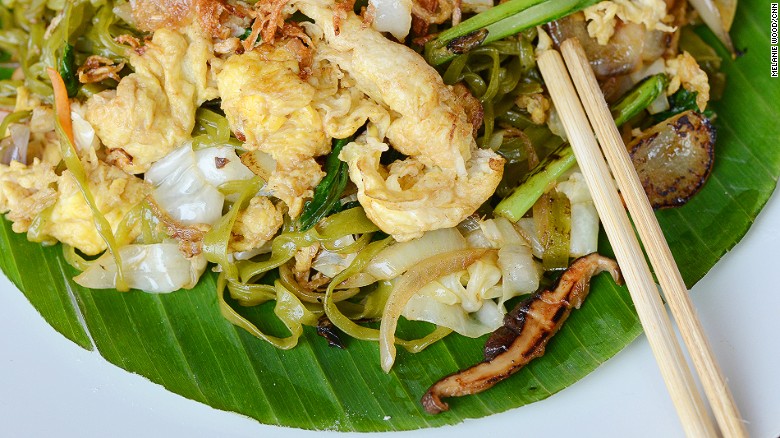 Bakmi Goreng |
Noodles compete with rice for carbohydrate of choice in Indonesia, ranging from broad and flat (kwetiau) to scrawny vermicelli (bihun).
The best are bakmi — pencil-thin and, in this case, fried with egg, meat and vegetables. Vendors add their own special spices for distinction, but the iconic Bakmi Gajah Mada garners a cult following. More modern outlets now make noodles from spinach and beets. Bakmi Gang Mangga gives diners an in to the cool hangouts in the old city, but only after 5 p.m. For an earlier version, try Bakmi GM on Jl. Sunda. |
|
| 11 |  Gudeg |
Fit for a sultan it may not be, but gudeg is certainly the signature of the royal city of Yogyakarta.
The sweet jackfruit stew is boiled for hours in coconut milk and palm sugar, making the fruit so soft and tender it falls apart with little chewing. Other spices are thrown into the mix but teak leaves give it a brown coloring. Like nasi uduk, it’s served with rice, boiled egg, chicken and crispy, fried beef skin. |
Adem Ayem, Jl. Slamet Riyadi 342, Solo |
| 12 |  Rawon |
A beef stew from East Java that goes heavy on the keluak nut to give it a nutty flavor and a deep, black color.
The soup base also mingles with garlic, shallots, ginger, turmeric and red chili to make it nice and spicy. The most famous variant is called Rawon Setan (Devil’s soup) in Surabaya. |
Rawon Setan, Jl. Embong Malang, Kota Surabaya, Jawa Timur |
| 13 |  Pecel Lele |
The sight of fried catfish may surprise first-time diners since it looks almost the same as it does living.
Served with rice and red and green sambal, this is simple street fare that fills the belly, which may be why it’s a standout across Jakarta. |
Bakmi GM, Jl. Sunda no 9 Thamrin | Sarinah 3 & 4 Fl, Jakarta |
| 14 |  Opor Ayam |
Small diners, called warungs, now sell this traditional dish of braised chicken in coconut milk on a daily basis.
Still, it remains a staple on tables around the end of Ramadan, when it’s served with packed rice cakes (ketupat). A little like a mild, slightly chalky curry with less prep time required, it’s filled with Indonesia’s signature spices — garlic, ginger, cumin and coriander. |
Masakan Rumah Ibu Endang, Jl. Cipete Raya No. 16C, Fatmawati, Jakarta |
| 15 |  Mie Ayam |
For this dish, bakmie is boiled in stock and topped with succulent slices of gravy-braised chicken.
Chives and sambal add extra flavor — but if it’s done right little else is needed. Unlike most Indonesian cuisine, where the secret is in the sauce, the clue to a good mie ayam is the perfect al dente noodle. Bakmi Orpha, a hole in the wall in west Jakarta, draws Ferrari-owning clientele for its deceivingly tasty mie and wontons. |
Bakmi Orpha, JL. Malaka II No. 25, Daerah Khusus Ibukota Jakarta; +62 21 691 2450 |
| 16 |  Babi Guling |
Pork is uncommon in this Muslim majority nation, but we had to include roast suckling pig given the near hysteria it generates on the Hindu island of Bali.
The Balinese respect their food and lavish attention on its preparation. Before spit-roasting the pig they bath it in coconut water and rub it with chili, turmeric, garlic and ginger to ensure succulence. Babi guling fans fly from Jakarta to scarf the crispy skinned pork at Warung Ibu Oka — but be sure to get there before 3 p.m. |
Warung Ibu Oka, Jl. Suweta sidestreet, Kuta, Bali |
| 17 |  Gulai |
Gulai is the common name for curry dishes, namely those from north Sumatra.
Indonesian curries have regional variations that depend on the types of meat and fish available — though gulai almost always incorporates cinnamon. Opor and rendang can be considered gulais, but better to try out the rainbow of other options. Pagi-Sore is a national franchise serves a tangy fish-head curry. |
Pagi-Sore, Jl. Pondok No. 143, Padang |
| 18 |  Bubur Ayam |
From blue-collar workers to government ministers, almost everyone starts their day with this rice gruel, a savory porridge served with soy sauce, fried shallots, shredded chicken, beans and crackers.
Outside Java variations can include corn, cassava and fish, while a sweeter version — for those who prefer not to start their day with a blast of chili — is made with mung beans. |
Bubur Ayam Mang H Oyo, Jl. Sulanjana No.30, Bandung, Jawa Barat |
| 19 |  Bakpao |
Jakarta gridlock may be a blessing for the bakpao market.
Vendors often line busy roads during rush hour to offer these fluffy meat-filled buns to hungry passersby in need of a snack. Sweet offerings include chocolate and green bean, indicated by a colored dot on top. No need to go in search of them, they’ll find you. |
– |
| 20 | 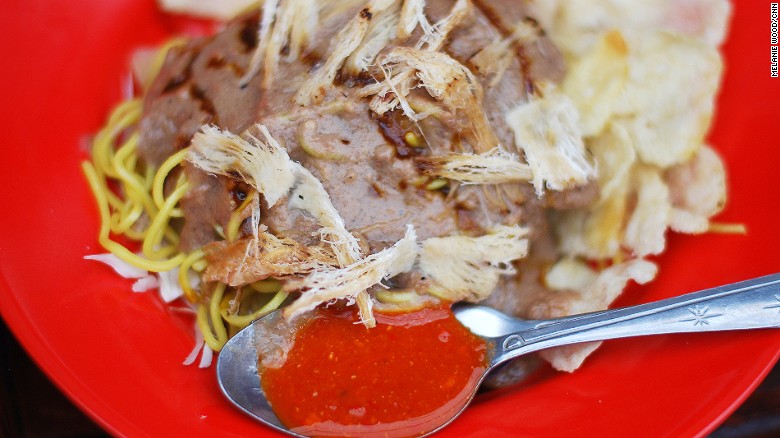 Asinan Sayur |
When palates crave the opposite of Javanese sweetness, this pickled vegetable salad offers reprieve.
The secret is in the dressing, a thin peanut sauce swirled with palm sugar to offset the salty snap of preserved mustard leaf, carrot, cabbage and cucumber. The krupuk cracker crunch comes from a yellow disc made with egg noodles. Yaya has been serving up bowls of Asinan for 22 years outside the iconic Ragusa Ice Cream shop. He also makes a mean dried-squid salad called juhi. |
Outside Sate Ragusa, Jl. Veteran 1 No. 10, Gambir, Jakarta |
| 21 |  Cah Kangkung |
Otherwise known as water spinach, a common river weed, kangkung gets stir fried with sweet soybean sauce, huge slices of garlic, bird’s-eye chili and shrimp paste to take it from a poor man’s food to something with a kick.
Because it grows well in any kind of soil, it is a common ingredient in dishes throughout Asia. Here the cah indicates its Chinese origins. |
Santika Baru Seafood, Jl. Bendungan Hilir Raya Kav. 36A, Daerah Khusus Ibukota Jakarta |
| 22 |  Pepes Ikan |
Pepes signifies the steaming of food in banana leaves, which gives it an earthy flavor that works well with the rich Manadonese spices (woku) it’s coupled with.
When matched with tuna the result is a dense, fiery dish that holds its distinct flavors, but should be eaten gingerly. |
Beautika, Jl. Hang Lekir No. 1, Kebayoran Baru; +62 21 722 6683 |
| 23 | 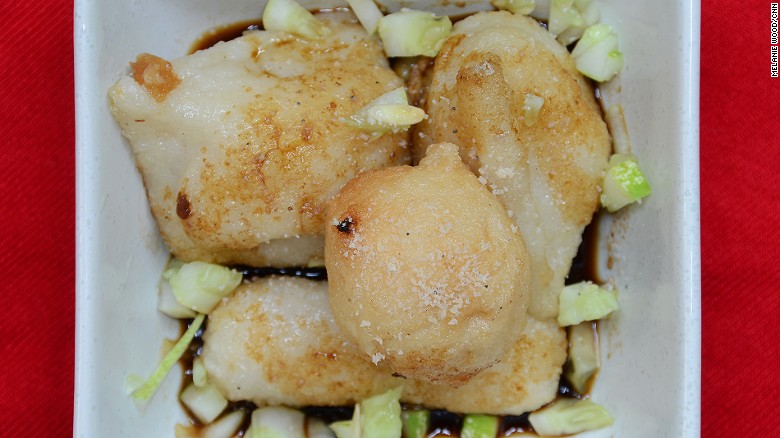 Pempek |
According to lore, the name pempek refers to the old Chinese man who first produced these fish and tapioca cakes from Palembang in South Sumatra.
Now a Palembang specialty, pempek or empek-empek comes in a variety of shapes and sizes. The most famed, kapal selam, or translated as submarine, contains a chicken egg and is rumored to be the most nutritious form of the spongy dough balls, which are sprinkled with shrimp powder and served withcuka, a dark dipping sauce made from vinegar, chili and sugar. |
Kebon Sirih, Palembang |
| 24 |  Perkadel |
So simple it’s often overlooked, Perkadel’s unassuming appearance belies its flavorful punch.
A distant relative of Dutch minced-meat frikandel, these croquettes are either potato based and filled with beef or made from corn (perkadel jagung). In Bandung, crowds line up late night in seedy alleyways to snack on potato fritters made soft from frying in hot oil. |
– |
| 25 |  Martabak |
Think of a spongy, thick crepe made with 10 times the lard and you’ll be somewhat close to imaging martabak.
The sweet version looks more like a pancake filled with gooey chocolate, peanuts or cheese, while the savory one is made from crispy pulled pastry like filo that is flattened in a wok as egg and minced meats are rapidly folded in. Served with pickled cucumber and a sweet and sour vinegar. |
Martabak Ayah, Muhammad Daudsyah, Jl. Tgk Diblang, Kota Banda Aceh |
| 26 |  Sayur Asem |
This clear, refreshing soup derived from tamarind pairs well with fried food since it’s stocked with vegetables and some of Indonesia’s most interesting ingredients: melinjo, bilimbi, chayote.
A very close relative called sayur lodeh is made with coconut milk and has a sweeter flavor. |
Warung Surabaya, Jl. DR. Abdul Rachman Saleh, Jakarta |
| 27 |  Sop Buntut |
Revitalized by the chef at Hotel Borabodor in 1973 after a food and beverage staffer saw a government minister eating a bowl on the street, oxtail soup is loved by Indonesians from all classes.
The high-end version — now the domain of Indonesia’s diplomatic corps — uses imported Australian beef, 7,000 kilograms a month to be precise, and comes complete with steamed rice, pickles, lime and sambal. Its less pretentious outlet Sop Buntut Bogor Cafe is now in Pacific Place Mall. |
Sop Buntut Bogor Cafe, Pacific Place Mall, level 5, Jl. Jenderal Sudirman, SCBD, Jakarta; +62 21 5797 3238 |
| 28 |  Ketoprak |
Not to be confused with the theatrical drama of the same name that re-enacts Javanese legends, this Ketoprak is made from vermicelli, tofu, packed rice cake and bean sprouts.
It rounds out the quintet of pestle-and-mortar-based dishes that include gado-gado and pecel, and is a simple street dish that tastes mostly of peanuts and spice but is chockfull of carbohydrates. |
Any street vendors |
| 29 |  Balado Terong |
The color of this dish is enough to set taste buds going.
Nothing more than grilled purple eggplant topped with heaps of chili sauce made from dried shrimp paste (balacan), it calls for a substantial portion of rice to even out the fire engine flavor. |
Seribu Rasa, Jl. Haji Agus Salim No. 128, Menteng, Daerah Khusus Ibukota Jakarta; +62 21 392 8892 |
| 30 |  Lontong Sayur |
Boiled for hours in coconut leaf casings, the glutinous packed rice cake known as lontong is one of the best vehicles for pairing with thick peanut sauces and curries.
It serves as the base for this savory morning favorite, a coconut-milk curry made with young papaya, soy-braised tofu and hard-boiled eggs. Crushed up krupuk add a little crunch to get you going. |
Pak Sule’s stand, outside the ANZ building on Jl. Gatot Subroto |
| 31 |  Rendang |
Perhaps Padang’s most famed curry, rendang is not an everyday food since it takes time and skill to make.
Its secret is in the gravy, which wraps around the beef for hours until, ideally, it’s splendidly tender. A dried version, which can be kept for months (like jerky) is reserved for honored guests and important celebrations. |
Restoran Sederhana, Jl. Gandaria Tengah III No. 23, Jakarta; +62 21 725 0172 |
| 32 |  Tahu Gejrot |
These clouds of golden, fried tofu look like little packages behind the windows of the boxes from which they are sold.
Tofu is a poor man’s snack, but that also makes it prevalent. Menteng Plaza has a version of fluffy tofu steeped in sweet soy sauce and chili and served in a pestle and mortar. |
Taman Menteng, Jl. HOS Cokroaminoto, Jakarta |
| 33 | 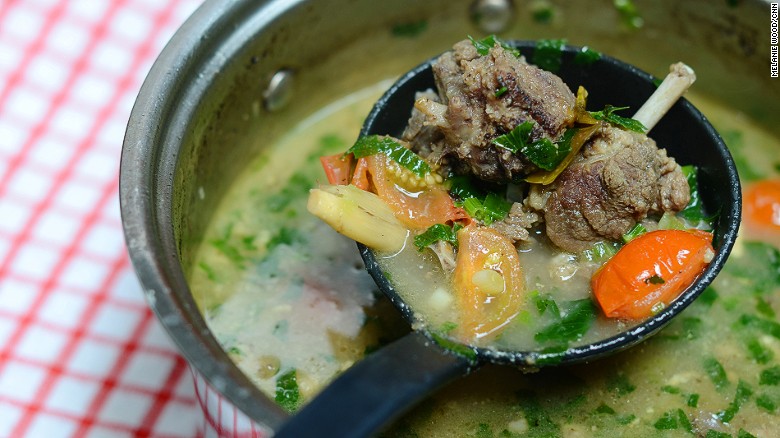 Sop Kambing |
If Indonesia ever got cold enough to necessitate a winter stew, sop kambing would be even more popular.
A robust soup with a yellow broth full of celery, tomato, and great chunks of goat meat, this dish could make the Campbell’s soup man quiver. Be warned if you have high blood pressure since the dish will heat you up. Ginger, lime leaf, candlenut and spring onion give it peppery smell that adds to its refreshingly earthy flavor. |
Sop Kaki Kambing stands among a number of roadside street vendors, Jl. Kendal, Menteng, Jakarta |
| 34 |  Siomay |
Think of it as Indonesia’s version of dim sum — traditional steamed fish dumplings known in China as shaomai. A complete portion comes with a steamed potato, cabbage, egg, and bitter gourd, and is served with a boiled peanut sauce similar to gado-gado. Perhaps Indonesia’s most ubiquitous traveling street food, the best way to dine on siomay is from a bicycle vendor, who carts his large steamer around on the back of his bike. For the less health-inclined, an alternative to siomay is batagor, which is fried instead of steamed. |
Siomay Pak Lili, Jl. Geger Kalong Girang, Bandung |
| 35 | 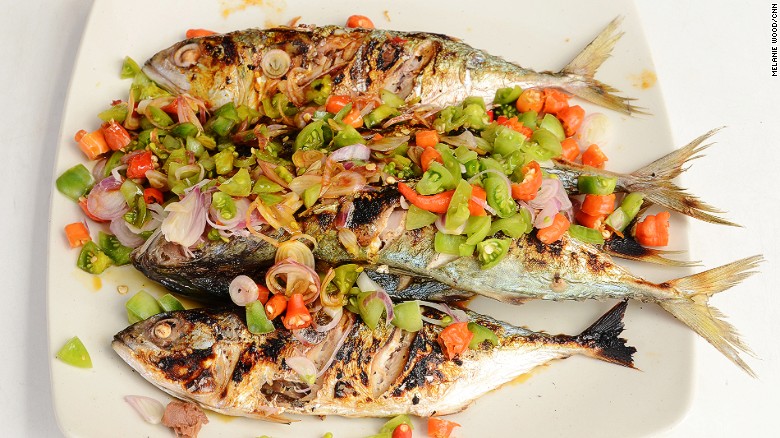 Ikan Bakar |
Grilled fish, plain and simple. But in a country with more than 17,000 islands, fish is bound to feature prominently.
While squid and prawns have a place in Indonesian cuisine, ikan bakar gets a far better showing for a fleshy texture that is great for dipping. It is usually marinated in the typical trove of spices and served with a soy and chili-based sauce. |
Ikan Bakar Cianjur, Jl. Cipete Raya No.35, Cilandak, Kota Jakarta Selatan, Daerah Khusus Ibukota Jakarta; +62 21 7590 0222 |
| 36 |  Daun Pepaya |
Papaya is one of the fastest growing trees in Southeast Asia, and its bitter leaves are great for sauteing.
This dish is common in Manado, but regional variations have made it popular among the leaf-and-seed-eating crowd, a big bunch in Indonesia. |
Bumbu Desa, Jalan Suryo No. 38, Kebayoran Baru, Daerah Khusus Ibukota Jakarta; +62 21 720 1244 |
| 37 |  Otak-otak |
Another famed fish cake from Palembang, otak-otak has a more charming appearance, since it’s wrapped in banana leaves before being grilled over charcoal.
Indigenous Sumatrans eat it with red chili mixed with fermented soy sauce, but in Jakarta it is served with Java’s ubiquitous peanut sauce. |
Harum Manis, Pavilion Apartment, Jl. KH Mas Mansyur Kav. 24, Daerah Khusus Ibukota Jakarta; +62 21 5794 1727 |
| 38 |  Bebek Goreng |
Ducks are common companions to rice fields around Indonesia, but they can be difficult to prepare for consumption.
Too often fried duck comes as a mass of tiny bones and overly fried oily meat. That doesn’t make it any less worthy of the top 40, though. |
|
| 39 |  Gorengan |
Or simply “fried foods,” gorengan are the most prolific snacks in all of Indonesia.
Street carts typically offer crispy golden nuggets of tempe, cassava and tofu, as well as fried bananas, sweet potatoes, vegetables fritters made from shredded carrot, cabbage and bean sprouts and fermented soybean cakes. |
Any kaki lima which serves an oil-stained news-wrapping gorengan topped with a handful of green chili |
| 40 |  Indomie |
f you had to name one food Indonesians couldn’t live without, it would have to be one that is easy to transport, since they’re often on the go.
That makes instant noodles Indomie beloved by all. Sold at grocery stores, village mom and pop shops and even from the basket of bicycles, Indomie calls for nothing more than hot water and a packet of chemical-induced flavoring before it’s ready to fill one’s tummy. |
– |
